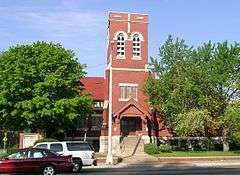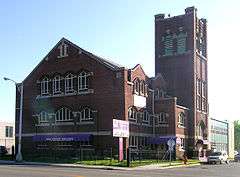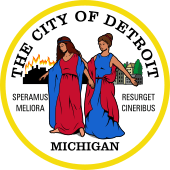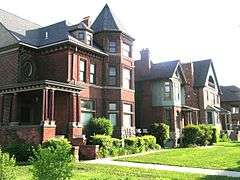Highland Park, Michigan
| Highland Park, Michigan | |
|---|---|
| City | |
| City of Highland Park | |
 Location in Wayne County and the state of Michigan | |
| Coordinates: 42°24′13″N 83°6′6″W / 42.40361°N 83.10167°WCoordinates: 42°24′13″N 83°6′6″W / 42.40361°N 83.10167°W | |
| Country | United States |
| State | Michigan |
| County | Wayne |
| Incorporated (village) | 1890 |
| Incorporated (city) | 1918 |
| Government | |
| • Type | Council-Mayor |
| • Mayor | Hubert Yopp |
| Area[1] | |
| • Total | 2.97 sq mi (7.70 km2) |
| • Land | 2.97 sq mi (7.69 km2) |
| • Water | 0 sq mi (0 km2) |
| Elevation | 636 ft (194 m) |
| Population (2010)[2] | |
| • Total | 11,776 |
| • Estimate (2012[3]) | 11,689 |
| • Density | 3,965.0/sq mi (1,530.9/km2) |
| Time zone | EST (UTC-5) |
| • Summer (DST) | EDT (UTC6) |
| ZIP code | 48203 |
| Area code(s) | 313 |
| FIPS code | 26-38180 |
| GNIS feature ID | 0628251[4] |
| Website | highlandparkcity.org |
Highland Park is a city in Wayne County in the State of Michigan, within Metro Detroit. The population was 11,776 at the 2010 census. The city is completely surrounded by Detroit except for a small portion that touches the city of Hamtramck, which is also surrounded by Detroit.
History
The area that was to become Highland Park began as a small farming community, on a large ridge located at what is now Woodward Avenue and Highland, six miles (9.7 km) north of Detroit. In 1818, prominent Detroit judge Augustus B. Woodward bought the ridge, and platted the village of Woodwardville in 1825. The development of the village failed. Another Detroit judge, Benjamin F. H. Witherell, son of Michigan Supreme Court justice James Witherell, attempted to found a village platted as Cassandra on this site in 1836, but this plan also failed.[5]
By 1860, the settlement was given a post office under the name of Whitewood. After a succession of closures and reopenings of the rural post office, the settlement was finally incorporated as a village within Greenfield Township and Hamtramck Township under the name of Highland Park in 1889.[6]
In 1907, Henry Ford purchased 160 acres (65 ha) just north of Manchester Street between Woodward Avenue and Oakland Street to build an automobile plant. Construction of the Highland Park Ford Plant was completed in 1909, and the area's population dramatically increased just a few years later in 1913, when Henry Ford opened the first assembly line at the plant. The village of Highland Park was incorporated as a city in 1918[7] to protect its tax base, including its successful Ford plant, from Detroit's expanding boundaries.
In 1910 Highland Park, then a village, had 4,120 residents. Between 1910 and 1920 during the boom associated with the automobile industry, Highland Park's population grew to about 46,500, an increase of 1,081 percent. The growth of Highland Park and neighboring Hamtramck broke records for increases of population; both municipalities withstood annexation efforts from Detroit.[8] In 1925, Chrysler Corporation was founded in Highland Park. It purchased the Brush-Maxwell plant in the city, which would eventually expand to 150 acres, and serve as the site of the company's headquarters for the next 70 years.[5]
Arthur Lupp of Highland Park founded the Michigan branch of the Black Legion in 1931; it was a secret vigilante group related to the Ku Klux Klan, which had been prominent in Detroit in the 1920s. The Legion had a similar nativist bent and its members were opposed to immigrants, Catholics, Jews, blacks, labor organizers, etc. Numerous public and business officials of Highland Park, including the chief of police, a mayor, and a city councilman, joined this group. Lupp and others were among a total of 48 men indicted and convicted following the murder of Charles Poole in May 1936; eleven were convicted in that murder. Investigations revealed the Legion had been involved in numerous other murders or conspiracies to murder during the previous three years, for which another 37 men were convicted.[9][10] These convictions ended the reign of the Legion.
In 1944, the Davison Freeway was opened as the country's first modern depressed urban freeway, running through the center of the city.[11] The freeway was completely reconstructed and widened in 1996 and 1997 to improve its safety.[12]
Ford Motor Company wound down operations at its Highland Park plant in the late 1950s. With the loss of industrial jobs, the city suffered many of the same difficulties as Detroit: declines in population and tax base accompanied by an increase in street crime. White flight from the city accelerated after the 1967 Detroit 12th Street Riot. Ford's last operation at the factory, the production of tractors at its Model T plant, was discontinued in 1973, and a year later the entire property was sold to a private developer for general industrial usage.[5] The city population was majority black and impoverished by the 1980s. Chrysler, the last major private sector employer in the city, moved its corporate headquarters from Highland Park to Auburn Hills between 1991 and 1993, paying the city a total of $44 million in compensation.[5] The move dislocated a total of 6,000 jobs over this period.[5]
Known as "The City of Trees,"[13] the town was thickly forested until the 1970s. The spread of Dutch elm disease required many old trees to be cut down.
In June 2001, because of the Highland Park's mounting fiscal crisis, an emergency financial manager for the city was appointed under the supervision of the State of Michigan. In April 2009, state officials fired Arthur Blackwell as Highland Park's emergency financial manager for over-payments that Blackwell received; they appointed Robert Mason as the new emergency financial manager.[14]
In August 2011, more than two-thirds of the streetlights in Highland Park were removed by the city, due to an inability to pay a $60,000 per month electric bill.[15] The street lights were not only turned off, but decommissioned, or removed from their posts. The city advised residents to keep porch lights on in order to deter crime.[16]
On November 20, 2013 the Detroit Water and Sewerage Department filed a lawsuit against the City of Highland Park regarding unpaid sewage services and water totaling $17.7 million.[17]
Geography
According to the United States Census Bureau, the city has a total area of 2.97 square miles (7.69 km2), all land.[1]
Highland Park is approximately 6 miles (9.7 km) north-northwest from Downtown Detroit. It is bounded by McNichols Road (6 Mile Road) to the north, Grand Trunk Western Railroad Holly Subdivision tracks to the east, the alleys of Tuxedo and Tennyson streets to the south, and the Lodge Freeway and Thompson Street to the west.
Demographics
| Historical population | |||
|---|---|---|---|
| Census | Pop. | %± | |
| 1900 | 427 | — | |
| 1910 | 4,120 | 864.9% | |
| 1920 | 46,499 | 1,028.6% | |
| 1930 | 52,959 | 13.9% | |
| 1940 | 50,810 | −4.1% | |
| 1950 | 46,393 | −8.7% | |
| 1960 | 38,063 | −18.0% | |
| 1970 | 35,444 | −6.9% | |
| 1980 | 27,909 | −21.3% | |
| 1990 | 20,121 | −27.9% | |
| 2000 | 16,746 | −16.8% | |
| 2010 | 11,776 | −29.7% | |
| Est. 2015 | 10,949 | [18] | −7.0% |
2014 Estimate[20] | |||
2010 census
As of the census[2] of 2010, there were 11,776 people, 4,645 households, and 2,406 families residing in the city. The population density was 3,965.0 inhabitants per square mile (1,530.9/km2). There were 6,090 housing units at an average density of 2,050.5 per square mile (791.7/km2). The racial makeup of the city was 93.5% African American, 3.2% White, 0.3% Native American, 0.4% Asian, 0.4% from other races, and 2.3% from two or more races. Hispanic or Latino of any race were 1.3% of the population.
There were 4,645 households of which 28.8% had children under the age of 18 living with them, 13.0% were married couples living together, 32.3% had a female householder with no husband present, 6.5% had a male householder with no wife present, and 48.2% were non-families. 43.4% of all households were made up of individuals and 16.1% had someone living alone who was 65 years of age or older. The average household size was 2.36 and the average family size was 3.30.
Highland Park has the highest percent of single people, 87%, of any city in Michigan.[21]
The median age in the city was 40.5 years. 23.7% of residents were under the age of 18; 10% were between the ages of 18 and 24; 21.9% were from 25 to 44; 30% were from 45 to 64; and 14.4% were 65 years of age or older. The gender makeup of the city was 49.2% male and 50.8% female.
2000 census
As of the census of 2000, there were 16,746 people, 6,199 households, and 3,521 families residing in the city. The population density was 5,622.9 people per square mile (2,169.7/km²). There were 7,249 housing units at an average density of 2,434.1 per square mile (939.2/km²). The racial makeup of the city was 4.11% White, 93.44% African American, 0.27% Native American, 0.24% Asian, 0.02% Pacific Islander, 0.25% from other races, and 1.67% from two or more races. Hispanic or Latino of any race were 0.57% of the population.
There were 6,199 households out of which 27.6% had children under the age of 18 living with them, 17.0% were married couples living together, 33.4% had a female householder with no husband present, and 43.2% were non-families. 38.4% of all households were made up of individuals and 15.6% had someone living alone who was 65 years of age or older. The average household size was 2.56 and the average family size was 3.43.
In the city the population was spread out with 29.1% under the age of 18, 8.6% from 18 to 24, 27.5% from 25 to 44, 20.2% from 45 to 64, and 14.5% who were 65 years of age or older. The median age was 34 years. For every 100 females there were 85.7 males. For every 100 females age 18 and over, there were 79.6 males.
The median income for a household in the city was $17,737, and the median income for a family was $26,484. Males had a median income of $31,014 versus $26,186 for females. The per capita income for the city was $12,121. About 32.1% of families and 38.3% of the population were below the poverty line, including 47.1% of those under age 18 and 30.8% of those age 65 or over.
Between the 1990 Census and the 2000 Census, the population decreased by 17%.[22]
Government and infrastructure
Municipal services
Highland Park is governed under the council-mayor form of government wherein an elected mayor is the chief executive and administrative officer of the city, and the council its legislative body. The mayor appoints city officers such as the city attorney, the director of community and economic development, finance director, and the water department director, though, the council has the power to refuse or accept the appointments. The city council consists of five members elected at large who serve terms of four years. The highest vote getter becomes council president for that term.[23]
However, using the Public Act 72 of 1990, Governor John Engler appointed an emergency financial manager to take over the financial operations of the city in December 2000, effectively relegating the mayor, city council, and other elected public officers to advisory roles. Ramona Henderson-Pearson was appointed the city's first emergency financial manager.[24] In December 2001, the city police department was formally disbanded, at which time the Wayne County Sheriff Department took over policing the city.[25] The Highland Park Police Department was re-established on July 1, 2007.[26] The city was returned to local control in July 2009 by Robert Mason, the city's last emergency financial manager.[27]
In 2012 Mark Binelli, author of Detroit City is the Place to Be, wrote that Highland Park is "the Detroit of Detroit" due to being in an overall poorer condition than the City of Detroit.[16] He stated that "[t]here was occasionally talk of Detroit absorbing Highland Park" but because the City of Detroit is uninterested in "adding more crime, blight, and desperately poor people to its own mean buffet of urban pathologies", the proposal to take Highland Park is "wishful thinking".[13]
Police Department
The Highland Park Police Department originally worked out of a building built in 1917 along Gerald Street. Its administrative offices are now in the Robert Blackwell Municipal Building,[28] and the patrol station is located in a mini-station in the Model-T Plaza strip mall.[16][28] It has occupied that facility since 2007. The jail facility there is a makeshift chain-link cage.[16] The police department has a business liaison office in the Woodward Place Plaza.[28] From 2001 to 2007 the municipal police department was inactive, with policing done by the Wayne County Sheriff's Department.[16] The police department reopened on July 1, 2007.[28]
Fire Department
The Highland Park Fire Department (HPFD) was established in 1917, and housed in a station built on Gerald Street.[29] Deemed uninhabitable in 2005, the department was moved to a temporary location in a warehouse on Oakland Avenue near the Davison Freeway. Using a $2.7 million Federal Emergency Management Agency grant made available by the American Recovery and Reinvestment Act, a new station facility was opened across the street from the original station on September 3, 2013.[30]
Police officers and firefighters in Highland Park, as of 2012, receive low pay relative to police and firefighters in other cities because the Highland Park public safety officers are no longer unionized.[31]
Federal services
The US Postal Service operates the Highland Park Post Office at 13215 Woodward Avenue.[32]
Economy
Chrysler was headquartered in Highland Park.[33] In 1992 the company announced that it was going to move its headquarters to its technology center in Auburn Hills, located approximately 25 miles (40 km) north of the original headquarters site.[34] The company planned to accomplish the move by 1995. In 1992 Chrysler had 25% of Highland Park's tax base and contributed 50% of the city's budget.[35] Chrysler had about 5,000 employees in Highland Park when it moved.[13]
In 2009 Magna International announced plans to start an automotive seat production operation in the former Chrysler headquarters.[36] The plant on the site of the former Chrysler headquarters opened in June 2010.[37]
The gear-reduction starter Chrysler used from the early 1960s through the late 1980s garnered the nickname "Highland Park Hummingbird" after Chrysler's hometown and the starter's distinctive cranking sound.
Despite Chrysler's departure, the city remains associated with Chrysler in the minds of auto enthusiasts.
Education
Primary and secondary schools

Highland Park is served by Highland Park Schools, which includes elementary and junior high school levels, and Detroit Public Schools at the senior high school level. Highland Park Community High School of Highland Park Schools closed in 2015.[38]
Northpointe Academy is a charter school located in Highland Park.[39]
The Roman Catholic Archdiocese of Detroit operated St. Benedict Elementary School in Highland Park. It closed in 2005.[40] Northpointe opened in the former St. Benedict after parents attempted to keep the former St. Benedict open.[39]
Colleges and universities
Lawrence Technological University was founded in 1932 in Highland Park, MI by the Lawrence brothers as the Lawrence Institute of Technology and adopted its current name in 1989. Lawrence Tech moved to Southfield, Michigan from its site in Highland Park, Michigan in 1955.[41][42]
Highland Park Community College was located in Highland Park before its 1996 closing.[43] It had previously been known as Highland Park Junior College.[44]
Public library
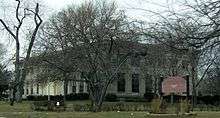
In 1918 Katherine and Tracy McGregor, wealthy individuals, deeded the property of a facility for "homeless, crippled, and backward children."[45] The McGregor Public Library opened on that site in 1924.[46] The library closed in 2002. Around 2007 the city began efforts to re-open the library.[47]
Parks and recreation
The Ernest T. Ford Recreation Center serves as a recreation center for the community. The center has a basketball court, exercise equipment, pool tables, table games, and televisions. After a renovation, it re-opened in February 2008.[48] In 1993 Highland Park Community College won the MCCAA Division 1 Men's Basketball Championship against Macomb Community College.
In popular culture
- 122 Beresford Street in Highland Park served as the filming location for a scene in the 2002 film 8 Mile where several of the movie's characters burn down an abandoned home. While the film company agreed to make a donation to the municipality, there were still protests in Highland Park given the city went through an arson spree that same year.[49]
- Highland Park is featured in the 2005 film Four Brothers, where it is the site of an armed convenience store robbery.[50]
- The 2007 documentary The Water Front chronicled the community's struggle against water privatization.[51]
- The 2008 film Gran Torino, starring and directed by Clint Eastwood, is primarily set in Highland Park.[52]
- A movie about a fictional lottery winner's attempt to reopen the McGregor Library, entitled Highland Park, starring Danny Glover, was filmed in October 2009 and released on video on demand in 2013.[53][54]
- Highland Park Ford Plant was one of the locations for the 2011 film Real Steel.[55]
- Highland Park was featured in an episode of American Diner Revival where they refurbished Red Hots Coney Island diner.[56]
Notable people
- Bobby Joe Hill, basketball player
- Pepper Adams, jazz saxophonist
- Bill Haley, rock and roll musician, born in Highland Park[57]
- Butch Hartman, animator
- Dick Lane, baseball player
- Joan Leslie, actress
- Adele Mara, actress
- Elvis Mitchell, film critic and author
- Billy Pierce, baseball player
- Johnny Werhas, baseball player and minister
- Jackie Wilson, soul singer
- Tim Meadows, Actor
- Telma Hopkins, Actress, Singer
- Terry Duerod, Basketball Player
- Keith McKenzie, Football Player
- Reggie Mckenzie, Football Player
- Edwin Baker (American football)
See also
References
- Binelli, Mark. Detroit City is the Place to Be. Metropolitan Books, Henry Holt and Company (New York). First Edition, 2012. ISBN 978-0-8050-9229-5 (hardback version).
- Howell, Sally. "Competing for Muslims: New Strategies for Urban Renewal in Detroit". Located in: Shryock, Andrew (editor). Islamophobia/Islamophilia: Beyond the Politics of Enemy and Friend. Indiana University Press, June 30, 2010. ISBN 0253004543, 9780253004543.
Notes
- 1 2 "US Gazetteer files 2010". United States Census Bureau. Retrieved 2012-11-25.
- 1 2 "American FactFinder". United States Census Bureau. Retrieved 2012-11-25.
- ↑ "Population Estimates". United States Census Bureau. Retrieved 2013-06-03.
- ↑ U.S. Geological Survey Geographic Names Information System: Highland Park, Michigan
- 1 2 3 4 5 Highland Park 2011 Master Plan, accessed 20 October 2011
- ↑ InfoMI.com, accessed April 18, 2007
- ↑ City of Highland Park Official History
- ↑ "Detroit Suburbs Ahead in Census." The New York Times. May 16, 1920. Retrieved on April 11, 2009.
- ↑ George Morris, "The Black Legion Rides", New York: Workers Library Publishers, August 1936, Internet Archive, accessed 16 September 2015
- ↑ Richard Bak, "The Dark Days of the Black Legion", Hour Detroit magazine, March 2009, accessed 16 September 2015
- ↑ Barnett, LeRoy (2004). A Drive Down Memory Lane: The Named State and Federal Highways of Michigan. Allegan Forest, MI: Priscilla Press. p. 66. ISBN 1-886167-24-9.
- ↑ "Governor Engler Celebrates Re-Opening of Davison Freeway One Month Early" (Press release). Office of the Governor. October 8, 1997. Retrieved November 8, 2008.
- 1 2 3 Binelli, p. 182.
- ↑ "Mason Named Highland Park Financial Manager", Department of Treasury. April 18, 2009. Retrieved on April 29, 2009.
- ↑ Associated Press. "Unable to pay $4 million electric bill, Michigan city turns off and removes many streetlights". Yahoo. Retrieved 2 July 2013.
- 1 2 3 4 5 Binelli, p. 183.
- ↑ Pardo, Steve and Candice Williams. "Detroit sues Highland Park for $17M in unpaid sewer bills." The Detroit News. November 23, 2013. Retrieved on December 1, 2013.
- ↑ "Annual Estimates of the Resident Population for Incorporated Places: April 1, 2010 to July 1, 2015". Retrieved July 2, 2016.
- ↑ United States Census Bureau. "Census of Population and Housing". Retrieved August 19, 2013.
- ↑ "Annual Estimates of the Resident Population: April 1, 2010 to July 1, 2014". Retrieved June 5, 2015.
- ↑ "Best Michigan Cities for Families and Singles". Michigan Real Estate Trends. RealEstate.com. Retrieved 5 February 2013.
- ↑ Howell, p. 210.
- ↑ The Charter of the City of Highland Park (1968)
- ↑ "State Will Manage Highland Park's Finances". WDIV-TV. 2000-12-06. Retrieved 2010-01-11.
- ↑ Smooth Transition Expected in Highland Park, Michigan Department of Treasury Press Release, December 14, 2001
- ↑ "Police Department." City of Highland Park. Retrieved on July 13, 2009.
- ↑ Treasury EFM Robert Mason Transfers Control Back to Highland Park, Pressbox Press Release, July 17, 2009
- 1 2 3 4 "Police Department." (Archive) City of Highland Park. Retrieved on November 1, 2013. "The Administrative Offices are located in the Robert Blackwell Municipal Building, 12050 Woodward Ave. Patrol Operations are conducted at the Highland Park Mini Station, located at 14112 Woodward, in the Model-T Plaza. The new Business Liaison Office is currently located at the Shoppes at Woodward Place Plaza, on Woodward Ave. at Sears Ave."
- ↑ "Fire Department." (Archive) City of Highland Park. Retrieved on November 1, 2013.
- ↑ Stables Battaglia, Tammy (3 September 2013). "2.7M Highland Park fire station up and running.". Detroit Free Press. Retrieved 25 November 2013.
- ↑ Binelli, p. 192. "Public safety officers in Highland Park were no longer unionized, which was how the city got away with compensating the cops and firefighters so pathetically."
- ↑ "Post Office Location - HIGHLAND PARK." United States Postal Service. Retrieved on April 17, 2009.
- ↑ Directory of American Research and Technology. Volume 24. Bowker, 1990. 101. Retrieved from Google Books on June 17, 2010. ISBN 0-8352-2702-2, ISBN 978-0-8352-2702-5. "CHRYSLER CORPORATION, 12800 Chrysler Dr, Highland Park, MI 48288-1 1 18."
- ↑ "COMPANY NEWS; Chrysler to Move Its Headquarters - New York Times". query.nytimes.com. September 9, 1992. Retrieved 2009-02-22.
- ↑ Brown, Warren. "Chrysler Moving Headquarters To Suburb of Detroit by 1995." The Washington Post. September 9, 1992. Financial F01. Retrieved on June 17, 2010.
- ↑ "Magna plans to open operation in former Chrysler headquarters in Highland Park, bringing 400 jobs." MLive.com and Associated Press. Tuesday July 21, 2009. Retrieved on August 18, 2009.
- ↑ Hulett, Sarah. "French Parts Supplier Gives New Hope to Highland Park." WUOM. Retrieved on June 17, 2010.
- ↑ Lewis, Sharon D. "Highland Park’s high school to close as enrollment dips" (Archive). The Detroit News. May 28, 2015. Retrieved on June 23, 2015. "Weatherspoon said high school students from Highland Park can enroll in nearby Detroit Public Schools, another neighboring district, a charter school or the state-run Education Achievement Authority. DPS will be the students’ home district."
- 1 2 "Home." Northpointe Academy. Retrieved on November 1, 2013. "NORTHPOINTE ACADEMY 53 Candler Street Highland Park, MI 48203"
- ↑ "15 Catholic Schools To Close In Metro Detroit." Click on Detroit. March 17, 2005. Retrieved on October 7, 2011.
- ↑ Michigan Historical Markers: Lawrence Institute of Technology (accessed 16 April 2015)
- ↑ Arthur M. Woodford, This is Detroit, 1701-2001, Chapter 18, page 214, Wayne State University Press, 2001, ISBN 0814329144
- ↑ "Highland Park Community College." Higher Learning Commission. Retrieved on March 30, 2009.
- ↑ Foley, Aaron (February 2, 2012). "From state-of-the-art to state takeover: The rise and fall of Highland Park Public Schools". mlive.com. Retrieved 2 February 2012.
- ↑ "McGregors gave land for library." The Detroit News. November 3, 1999. Retrieved on July 13, 2009.
- ↑ Trent, Kim. "Effort to restore Highland Park library gains strength." Michigan Chronicle. March 21, 2000. Retrieved on July 13, 2009.
- ↑ "McGregor Library." Crain's Detroit Business. July 13, 2007. Retrieved on July 13, 2009.
- ↑ "Ernest T. Ford Recreation Center." City of Highland Park. Retrieved on June 17, 2010.
- ↑
- ↑ Four Brothers: Review, TV Guide
- ↑ "Water Front Movie".
- ↑ Information About Clint Eastwood's "Gran Torino" and Hmong in Detroit, About.com
- ↑ Blumenstein, Lynn. "Film chronicles fictional rebirth of closed Highland Park library." Library Journal. October 8, 2009. Retrieved on November 4, 2011.
- ↑ Andrew Meieran, 'Highland Park' Film Director, Shares How Michigan City Opened His Eyes, Huffington Post
- ↑ Real Steel and Ides of March Open Nationwide, Michigan Film Office
- ↑ American Diner Revival: Retro Remix
- ↑ Palmer, Robert (1981-02-10). "BILL HALEY, 55, DIES; SINGER-BAND LEADER". The New York Times. ISSN 0362-4331. Retrieved 2016-03-06.
External links
| Wikivoyage has a travel guide for Hamtramck-Highland Park. |
| Wikimedia Commons has media related to Highland Park, Michigan. |
